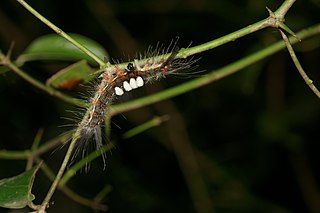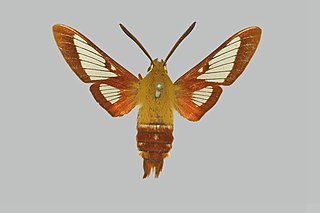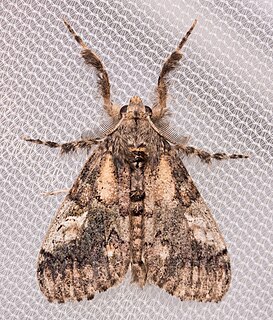
Coccoloba uvifera is a species of flowering plant in the buckwheat family, Polygonaceae, that is native to coastal beaches throughout tropical America and the Caribbean, including southern Florida, the Bahamas, the Greater and Lesser Antilles, and Bermuda. Common names include seagrape and baygrape.

The Lymantriinae are a subfamily of moths of the family Erebidae. The taxon was erected by George Hampson in 1893.

Halysidota tessellaris, also called the pale tiger moth, banded tussock moth, and tessellated halisidota, is in the family Erebidae and the tribe Arctiini, the tiger moths. The species was first described by James Edward Smith in 1797. Like many related species, adult moths have chemical defenses acquired from its host plants, in this case, alkaloids. Larval behaviors suggest that they are chemically protected; they have not been analyzed for alkaloid content.

Madoryx pseudothyreus, the false-windowed sphinx, is a moth of the family Sphingidae. The species was first described by Augustus Radcliffe Grote in 1865. It is known from the tip of Florida down to Cuba and the surrounding West Indies.

Citheronia sepulcralis, the pine-devil moth, is a Nearctic member of the family Saturniidae and of the subfamily Ceratocampinae. The species are blackish brown. The species was first described by Augustus Radcliffe Grote and Coleman Townsend Robinson in 1865.

Halysidota is a genus of moths in the family Erebidae. The genus was erected by Jacob Hübner in 1819.

Hemaris gracilis, the slender clearwing or graceful clearwing, is a moth of the family Sphingidae. The species was first described by Augustus Radcliffe Grote and Coleman Townsend Robinson in 1865. It is found in North America from Nova Scotia to central Florida along the East Coast and west through New England to Michigan to Saskatchewan. The species is listed as threatened in Connecticut.

Dasychira is a genus of tussock moths in the family Erebidae described by Jacob Hübner in 1809. They are well distributed all over Africa, Europe, Madagascar, Japan, China, India, Sri Lanka, Myanmar, Java and Australia.

Dasychira plagiata, the northern pine tussock or northern conifer tussock, is a moth of the family Erebidae. The species was first described by Francis Walker in 1865. It is found in North America from Newfoundland and Labrador to Alberta, in Massachusetts, New York and North Carolina.

Halysidota harrisii, the sycamore tussock moth, is a moth of the family Erebidae and the tribe Arctiini, the tiger moths. The species was first described by Benjamin Dann Walsh in 1864. It is found in southeastern Canada, the eastern parts of the United States, and northeastern Mexico.

Dasychira basiflava, the yellow-based tussock, is a moth of the family Erebidae. The species was first described by Alpheus Spring Packard in 1865. It is found in North America from Massachusetts and southern Ontario west to Iowa, Texas, south to South Carolina and possibly Florida.
Cisseps packardii is a moth of the subfamily Arctiinae. It was described by Augustus Radcliffe Grote in 1865. It is found in North America from California to Manitoba.

Halysidota davisii, or Davis' tussock moth, is a species of moth in the family Erebidae. It was described by Henry Edwards in 1874. It is found in Utah, Arizona, New Mexico and north-western Texas.
Halysidota schausi, or Schaus' tussock moth, is a species of moth in the family Erebidae. It was described by Walter Rothschild in 1909. It is found from Texas and Mexico to Costa Rica, Guatemala, Colombia, Venezuela, Ecuador and Peru. It is also found on Martinique and the Lesser Antilles.
Halysidota underwoodi, or Underwood's tussock moth, is a moth of the family Erebidae. It was described by Walter Rothschild in 1909. It is found in Mexico, Guatemala, Nicaragua, Costa Rica, Panama, Colombia, Venezuela, Ecuador, Peru and Bolivia.

Leucanopsis longa, the long-streaked tussock moth or long-streaked halisidota, is a moth of the family Erebidae. It was described by Augustus Radcliffe Grote in 1880. It is found from North Carolina to Florida and west along the coast to eastern Texas. The habitat consists of marshes and wet sedge meadows.

Cisthene packardii, or Packard's lichen moth, is a moth of the family Erebidae. It was described by Augustus Radcliffe Grote in 1863. It is found in the US from the states of New York to Florida and from Missouri to Texas. The habitat consists of barrens and dry oak woodlands in the northern part of the range and a variety of woodlands and scrubs in the south.
Prionoxystus piger, the baccharis carpenterworm moth, is a moth in the family Cossidae. It was described by Augustus Radcliffe Grote in 1865. It is found in Florida and Cuba.

Compacta capitalis is a moth in the family Crambidae. It was described by Augustus Radcliffe Grote in 1881. It is found in North America, where it has been recorded from Maryland to Florida, west to Texas and possibly Colorado, north to Illinois.













